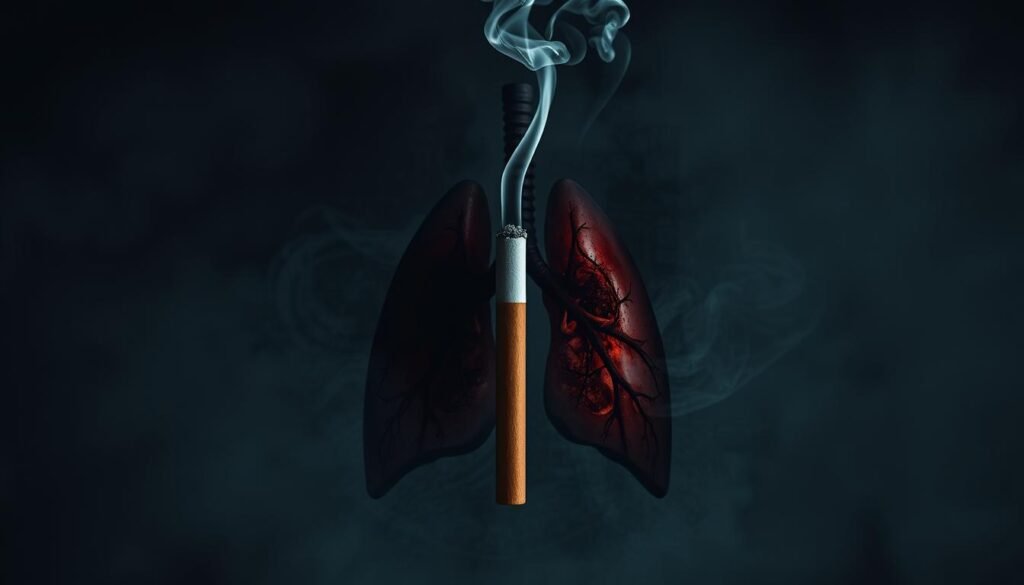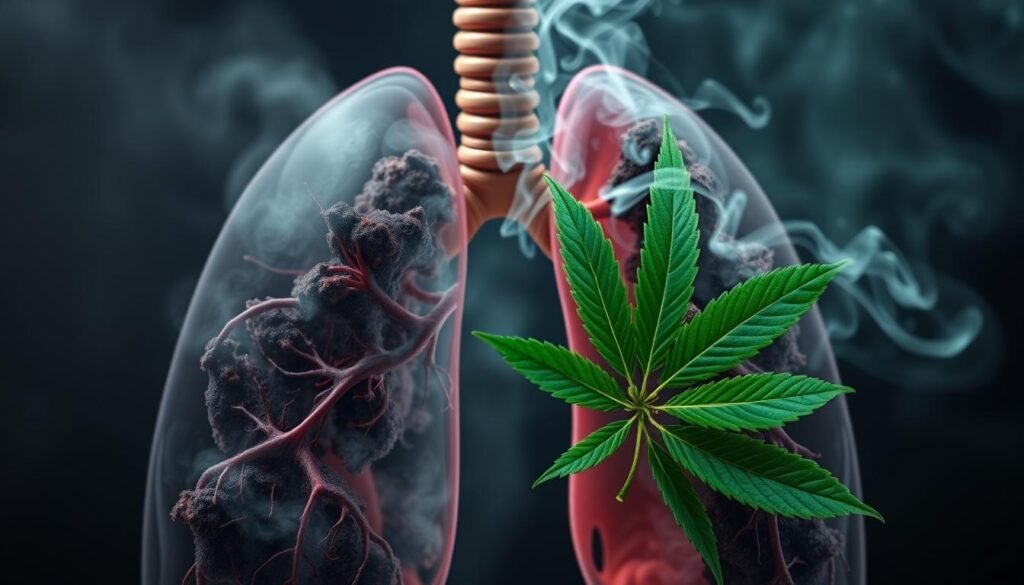Did you know that marijuana is the most commonly abused drug in the U.S.? It’s linked to a possible risk of lung cancer. As more people use cannabis, it’s vital to know how it affects lung health.
This is especially true when comparing it to tobacco, which is known to be dangerous. Studies show that both marijuana and tobacco smoke have harmful substances. These substances can cause chronic bronchitis, harm lung function, and may even be cancer-causing.
The American Lung Association warns about the harmful effects of both. They highlight the need for more research on how cannabis affects health. They also suggest looking into other ways to use cannabis that might lower the risk to lungs. This article will dive into the complex relationship between smoking marijuana, tobacco, and lung cancer.
Key Takeaways
- Marijuana smoke contains toxins similar to those found in tobacco smoke.
- Chronic bronchitis and respiratory damage are associated with marijuana use.
- Both marijuana and tobacco smoking are warned against due to lung health issues.
- Research is needed to fully understand the cancer risks linked to marijuana smoking.
- The American Lung Association advocates for harm reduction strategies in cannabis use.
- Alternative methods of using cannabis may help protect lung health.
Introduction to Smoking and Lung Health
It’s crucial to know how smoking affects lung health. Both tobacco and marijuana smoking can lead to serious problems. These include chronic obstructive pulmonary disease (COPD), lung cancer, and bronchitis. Smoking cigarettes causes about 443,000 deaths every year in the U.S., says the CDC. That’s nearly one out of every five deaths.
Studies show the toxins in marijuana smoke are like those in tobacco. But, cigarette smokers often smoke much more than marijuana users. Despite smoking less often, long-term use of marijuana can hurt lung health. This could lower how well the lungs work.
People who often smoke cannabis might cough a lot and wheeze. It’s complicated how these habits link to big health issues. Research into marijuana smoking and lung cancer gives mixed results. This is due to legal limits on marijuana use making reporting hard.
Getting medical advice early about smoking’s signs can make a difference in health. To learn more about the risks of COPD and lung cancer, click here.
| Smoking Type | Daily Usage | Health Risks |
|---|---|---|
| Tobacco | 10-20 cigarettes | High risk of lung cancer, COPD, chronic bronchitis |
| Marijuana | 2-3 times per month | Chronic cough, potential lung damage, unclear cancer links |
Understanding Tobacco Smoking
Tobacco smoking is a major health issue in the United States. It leads to many tobacco-related health problems. The smoke from tobacco has carcinogens that harm the respiratory system.
Nicotine in tobacco makes people dependent. It hooks users and makes them keep using harmful substances.
Smoking is the main cause of Chronic Obstructive Pulmonary Disease (COPD). COPD is a serious respiratory illness and a leading death cause. People who smoke for a long time often get chronic bronchitis.
Emphysema, another smoker’s disease, destroys lung tissue. These conditions result in a “smoker’s cough,” which is a sign of lung damage.
But there’s more than just lung issues. Tobacco smoking increases the risk of heart disease and stroke. It harms the heart and blood vessels. Women may have reproductive health problems because of smoking.
They risk having ectopic pregnancies and premature births. Men might face erectile dysfunction due to smoking.
Children and teenagers exposed to secondhand smoke are at risk too. They could get addicted to nicotine and suffer brain development issues. A study suggests the need for more research on the effects of tobacco.
It highlights the dangers of tobacco and cannabis. For more on this study, see this research.

Understanding Marijuana Smoking
Marijuana use is growing, especially among young adults in the U.S. This sparks concerns about how it affects lung health. The smoke from marijuana has both similar and different chemicals compared to tobacco. Knowing how marijuana is consumed and its effects on the lungs is important.
Chemical Composition and Inhalation Methods
People smoke marijuana in various ways, such as using joints, blunts, pipes, and vaporizers. Marijuana smoke has harmful chemicals like benzene and tar. These substances can cause cancer. However, how marijuana affects lung health is still under study. While smoking a lot of marijuana may pose risks, the link to lung cancer isn’t clear-cut. Some studies suggest that limited use might not drastically increase cancer risk. Yet, marijuana users often inhale deeply and keep the smoke in longer, which can harm the lungs.
Effects on Respiratory Health
Marijuana smoking can lead to respiratory issues. Users might face problems like chronic bronchitis more often than nonusers. Visits to the doctor for lung problems tend to be higher among smokers. Smoking marijuana is linked to chronic bronchitis, harming airway linings and causing symptoms like coughing and mucus. Research also shows that it can create air pockets in the lungs from inhaling toxins. This can weaken the immune system, making infections more likely. Although vaping is seen as a newer way to use cannabis, it might still have risks. This is especially true for devices from unregulated sources.
| Inhalation Method | Common Concerns | Potential Health Effects |
|---|---|---|
| Joints | Deep inhalation, holding smoke longer | Chronic bronchitis, airway damage |
| Blunts | Combustion of tobacco leaves | Increased exposure to carcinogens |
| Pipes | Continuous, deep inhalation | Respiratory symptoms, potential lung damage |
| Vaporizers | Unregulated products raising safety issues | Unknown lung health impacts, possible scarring |
Knowing these details helps people make smart choices about using marijuana. It’s key to think about how it might affect your lungs.
Marijuana Smoking vs Tobacco Smoking and Lung Cancer
The debate about lung cancer focuses on marijuana and tobacco smoking lately. We look into the carcinogenic properties of both to see their health effects. While tobacco smoke is linked to many lung cancer cases, marijuana smoke shows no consistent link. This suggests that health impacts vary between them.
Carcinogenic Properties of Each
Tobacco causes over 400,000 deaths every year in the U.S., many from lung cancer. Studies show tobacco smoke’s carcinogenic properties are significant. This leads to more cancer deaths. But, research like Hashibe et al.’s found no tie between marijuana smoke and lung or colorectal cancer. Cannabis might even have compounds like THC that could help protect against cancer.
Comparative Risks of Lung Cancer
Studies on cannabis and lung cancer show mixed results. Even though cannabis smoke holds more tars than tobacco, it’s not clearly tied to more lung cancer cases. A 2015 study also found little link between regular cannabis use and lung cancer.
On the contrary, nicotine in tobacco might fast-track cancer in the lungs. Meanwhile, cannabinoids could slow tumor growth. This paints a complex picture of smoking’s risks.
The combined effects of smoking both tobacco and marijuana still need more study. It’s vital to understand how each affects our health and lung cancer risks. Nowadays, more young adults mix tobacco and marijuana, which raises questions about each’s impact on lung cancer.

Continued research into smoking’s health implications is essential. It’s increasingly important to know how these habits interact. There’s a need to explore safer ways to use cannabis, especially for lung health. For more details, check out this thorough analysis here.
The Impact of Toxins and Irritants
Cannabis smoke and tobacco smoke are both harmful. They have compounds that can hurt lung health. Figuring out the impact of these toxins is key for anyone who smokes. Research finds they have carcinogens that can cause long-term lung issues and other serious problems.
The toxins in both smokes are similar but also different. Knowing this can help us understand how they affect health.
Shared Carcinogens and Their Effects on Health
Both smokes have common carcinogens that harm the lungs. These compounds can make lung inflammation worse and mess with how the lungs work. They can lead to long-lasting problems like emphysema, which makes it hard to breathe.
In the U.S., smoking tobacco is the top preventable cause of death. Secondhand smoke also causes major health problems.
Unique Toxins Found in Each Type of Smoke
Cannabis and tobacco smokes have some toxins that aren’t the same. For example, marijuana smoke has more tar. People tend to inhale it more deeply than tobacco smoke. This can damage the lungs more and make some health problems worse.
Understanding these unique toxins helps us see the risks of smoking marijuana compared to tobacco.

Research on Lung Cancer and Cannabis Use
Scientists have looked at how cannabis and cancer might be connected. They’ve found that smoking cannabis and getting lung cancer aren’t strongly linked. This conclusion comes from combining the results of six studies. They looked at over 2,100 people with lung cancer and nearly 3,000 without. They found that regular cannabis users didn’t have a higher risk of getting cancer.
Studies on Cannabis and Cancer Links
Research on cannabis and lung cancer shows different results. Some studies point to a slightly higher risk for very heavy cannabis users, especially if they don’t use tobacco. For example, one study showed heavy users had twice the risk of lung cancer. But, the overall risk for most cannabis users seems low, especially compared to tobacco users. A big review shows that we still can’t say for sure that smoking marijuana greatly increases cancer risk.
Findings from Recent Epidemiological Reviews
Recent reviews highlight the need to consider many factors in cancer risk. One major review found no clear link between marijuana smoking and lung cancer. It shows that marijuana might be less risky than tobacco. This is clearer when we account for things like family history. If you have a family history of lung cancer, the risk goes up significantly.
This is particularly true for those with a genetic risk. Their risk might be nearly four times higher.
| Study Type | Participants | Findings |
|---|---|---|
| Pooled Analysis | 2,159 cases, 2,985 controls | No significant association between cannabis smoking and lung cancer |
| Population-based Study | 49,321 military conscripts | 2-fold increase in lung cancer risk for heavy cannabis use |
| 2019 Meta-analysis | 25 studies | No definitive link established |
| 2021 Meta-analysis | 34 studies | Further affirmation of the absence of strong links |
Science keeps uncovering new facts. We have more to learn about cannabis and lung health. To really understand the relationship, we need better studies in the future.
Respiratory Health: Bronchitis and Other Conditions
Chronic bronchitis and other breathing problems are big worries for people who smoke marijuana or tobacco. Studies show that smoking pot regularly can lead to coughing, producing sputum, and feeling short of breath. These issues are similar to what tobacco smokers face. Knowing about these problems helps us understand how smoking affects our lungs and breathing.
Chronic Bronchitis Connected to Marijuana Use
People who smoke cannabis often can get chronic bronchitis. Their symptoms are like those seen in tobacco smokers. Research says these pot smokers may breathe out more air but show small drops in how fast they can exhale. Unlike tobacco smokers, who see a bigger decrease. The debate continues, but symptoms like lasting coughs and wheezing point to possible long-term lung damage from pot smoking.
Insights into Tobacco-Induced Respiratory Disorders
Tobacco smoking is well-known for causing serious lung diseases, like COPD. COPD includes chronic bronchitis and emphysema, which harm your lungs. Because tobacco smoke has many toxins, it greatly lowers lung function. Those with lung issues from smoking often fight against coughing, wheezing, and other breathing problems. To protect our lungs, we need to know how smoking marijuana and tobacco leads to these diseases.
Harm Reduction Strategies for Smokers
Looking at the serious health risks of smoking, it’s important to think about harm reduction. This is true for both tobacco and cannabis smokers. Using different methods can really help reduce the harm to lungs and health overall.
Alternative Methods of Cannabis Consumption
Trying different ways to use cannabis can cut down on smoke exposure. Some methods include:
- Edibles: Eating foods with cannabis is a way to avoid smoke.
- Oils and Tinctures: These are liquid cannabis products. They don’t require burning to work.
- Vaporization: Vaporizers heat cannabis without burning it. This reduces harmful smoke.
These options can help lower the risks for people who use tobacco and cannabis together. They can improve your health.
Mitigating Risks Associated with Tobacco Use
There are several ways to cut down or stop using tobacco. Some methods to quit smoking are:
- Nicotine Replacement Therapies: Products like patches and gums help with cravings.
- Behavioral Support Programs: Joining support groups or counseling can keep you motivated.
- Public Health Initiatives: Campaigns help support quitting on a larger scale.
Using these strategies can make a big difference in health for smokers. This is true for those using tobacco, cannabis, or both.
Conclusion
The health impacts of smoking marijuana and tobacco are complex. Tobacco smoking leads to over 400,000 deaths every year in the U.S. Cannabis is still being studied for its long-term effects. While it has more tars than tobacco, it’s not proven to cause certain cancers.
Some studies show cannabis might have compounds that fight cancer. This includes lung cancer. It makes us think about the risks of smoking weed versus tobacco. Even though weed has carcinogens, ingredients like THC could help protect us from cancer.
It’s crucial to know the effects of smoking both substances. This article wants to make everyone aware of the possible dangers. Making safer choices is key. As we learn more, staying informed helps us live healthier lives.